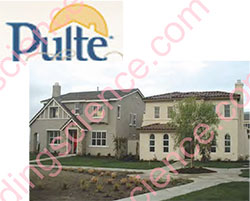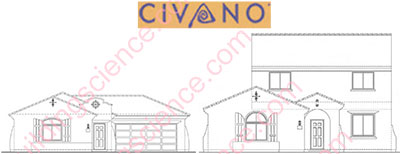Using four Building Science Consortium Building America community-scale projects, this paper investigates the nature, strength, and durability of connections between high performance dwellings and developments. There are few inherent or natural links between the two (particularly in the production home setting); the connections must be either imposed (by government entities) or created in the marketplace. Because communities often involve two very distinct players—the developer and the builders—and the project often spans up to 10 years, it is challenging to develop and sustain either an imposed or marketed system with strong and meaningful links between high performance homes and neighborhoods.
Introduction
It's not hard to find great examples of green developments — the ones with low impact on the local environment and landscape. It's also not that hard to find really great examples of resource- and energy-efficient homes — the ones designed and built for high performance. But what about projects that have accomplished both? And just how inherent are the links between resourceefficient development and structures?
As part of the Department of Energy's Building America program,1 the Building Science Consortium (BSC) works with production builders nationwide on the design, construction, and commissioning of high performance homes (see side bar). This paper is about BSC evaluation of four of its community-scale projects, searching for the nature, strength, and durability of the connections between high performance development and high performance homes. The four projects are:
- Hidden Springs – Boise, Idaho
- Prairie Crossing – Grayslake, Illinois
- Civano – Tucson, Arizona
- Terramor – Ladera Ranch, California.
The following fundamental questions about these projects yield many interesting answers and more questions:
- What criteria shape the homes and community; how binding are these criteria?
- What were/are the drivers of the project criteria; are they market-based, municipally-required, or both?
- Which communities have sustained their level of energy and resource performance over time, and why?
The Projects
What exactly is a high performance home?
The Building America systems approach to high performance is based on the premise that links among energy efficiency, indoor environmental quality, and building durability are inherent and immutable. The BSC approach to ensuring high performance involves plan and specification review, energy modeling, performance testing, and building commissioning. The following requirements constitute the lion’s share of our definition of high performance2:
- Superior energy performance — HERS rating of 88 or better.
- Mechanical ventilation per ASHRAE 62.2.
- All combustion appliances in the conditioned space sealedcombustion (furnaces and boilers) or power-vented (water heaters).
- All ducts and air handling equipment in the conditioned space.
- Performance testing for whole house and duct air tightness (per Energy Star testing regime); blower door of 2.5 in2/100 ft2 surface area leakage ratio or less; duct leakage of 5.0 percent or less of the total air handling system rated air flow at high speed.
- Interzonal air pressure differences, when doors are closed, of 3 Pascals or less.
These performance requirements — along with the system of plan and specification reviews — ensure that the high performance home is energy efficient; safe, comfortable, healthy; and durable, particularly in terms of resistance to the major damage vectors — heat, air, and moisture.3
Hidden Springs4 Hidden Springs is a community of 1135 homes located on 1844 acres with over 800 acres of protected wetlands, farmland, and natural wildlife areas. This project features a community center within walking distance of all homes, a charter school, its own post office, and miles of hiking and biking trails. Hidden Springs won the BALA Best Smart Growth Community in 2000.5 Homes range in price from approximately $185,000 to $750,000. Construction of homes began in June 1998 with build-out slated for December 2004. BSC began work with Hidden Springs under the Building America program in February 1998 with assistance tailing off in 2001. Approximately 32 homes were certified under the Building America program.

Prairie Crossing6 Prairie Crossing is a community of 362 homes on approximately 677 acres with approximately 60% of the total land area designated as protected open land. Homes range in price from $279,000 to $420,000. Construction began in June 1995; home construction is nearly 90% complete with the last of four neighborhoods well underway. This conservation community features an environmental education institute, organic farm, charter school, a storm water management lake (Lake Aldo Leopold) and a 20kW wind turbine.7 A critically acclaimed conservation community, Prairie Crossing has appeared extensively in national media — print, television, and radio. BSC work with Prairie Crossing began in June 1996 and ended in December 2002. Approximately 200 homes were built under the Building America program with BSC.


Terramor (Pulte Homes, Southern
California) 8 Terramor is a community of approximately 1,260 homes in 12 neighborhoods on 290 acres. Pulte Homes is building 75 homes in a neighborhood called Clairborne, with homes in the low $500,000s. A concept entitled “360° Living” is being employed at Terramor, a concept that includes green land planning and home building in the form of the Terramor Green Development program. Pulte has three models for this community, with 16 homes completed and another 11 currently under construction. Only the Pulte Homes at Terramor are being built to the BSC performance targets.
Civano (Pulte Homes, Tucson, Arizona) 9 Civano is a master-planned community of approximately 2,500 homes on 820 acres. In the second Civano neighborhood, Pulte Homes of Arizona plans to build between 1,200 and 1,300 homes on about 480 acres over a five-year period, with homes ranging in price from $120,000 to the upper $200,000s.10 Pulte will construct the Civano model homes in the latter part of 2004. Civano began as a partnership of local advocates and government officials called the “Solar Village.” The concept matured over time such that all homes must be designed and constructed in accordance with the Civano IMPACT11 System and Sustainable Energy Standard. The sustainability goals of the Civano system are impressive, and detailed in the next section of this paper.

The Nature, Strength, and Durability of Criteria and Connections
Hidden Springs This community is based on a set of Founding Principles12 with clear emphases on traditional neighborhood design and land preservation. The community developer is not legally bound in any way to the Founding Principles (in terms of government entities setting conditions for any permitting), but the developer does see the Founding Principles as an essential element of their marketing strategy.
Principle #4 of the Founding Principles is the most closely linked to the high performance criteria of Building America:
“We will encourage the design and construction of homes that are comfortable and long-lasting; homes that will use energy and resources efficiently and responsibly.”
This criterion is neither specifically performance-based nor quantitative, and the use of the verb “encourage” sets this principle apart from most of the others as a “softer” and less binding one. The Building America standards were incorporated into the Residential Design Guidelines only as "Suggested Building Practices" and "Suggested Design Measures."
Only one builder at Hidden Springs, Chuck Miller Construction, continues to build to the original Building America criteria for energy efficiency, indoor environmental quality, and durability. Chuck Miller Construction has built approximately 12 homes a year at Hidden Springs.13
Prairie Crossing This community is based on a set of Guiding Principles.14 As with Hidden Springs, most of the community criteria are related to traditional neighborhood design and land preservation. The Guiding Principles are not legally binding to the developer, since they were not a pre-condition of a local or state governmental authority for the community’s development. The Principles are, however, essential to the marketing strategy of the developer.
Criterion #7 relates specifically to energy conservation:
“Buildings at Prairie Crossing are being constructed with techniques that reduce energy consumption by approximately 50 percent, compared to new homes elsewhere in the area.”
This criterion is both performance-based and quantitative, one that any interested party can easily pursue with the developer and the builder. This criterion is linked to an unique aspect of Prairie Crossing — an alternative high performance building code, developed specifically by BSC for this community under the Building America program.
The compliance mechanism for the Lake County alternative code is the certificate of occupancy (CO) — the building inspector may not release the CO on a completed home until Section 326 compliance has been confirmed by the inspector, including performance testing results. Although this system was clearly designed to be “leakproof,” the actual chain of custody on building permits and approvals at Prairie Crossing challenges the system. The original approval for the Section 326 building permit comes from the Lake County . . .
Download complete report here.
Footnotes:
- For more information on the Building America program, see: http://www.eere.energy.gov/buildings/building_america.
- The complete list of performance targets, including recommendations not listed here, can be found on the
web at: http://www.buildingscience.com/buildingamerica/targets.htm - Building scientists often characterize the major damage functions as HARM—heat, air, radiation (UV
exposure) and moisture. Pests, particularly insects, are generally added to these for homes. - For more information on Hidden Springs, see the website: http://www.hiddensprings.com. For more
information on the lead builder at Hidden Springs, see http://www.chuckmillerconstruction.com. - BALA is the Best in American Living Award, a program of the National Association of Home Builders and
Professional Builder magazine. - For more information on Prairie Crossing, see their website: http://www.prairiecrossing.com.
- The 20 kW wind turbine is used to power irrigation at the Prairie Crossing Organic Farm.
- For more information on Terramor, see their website: http://www.laderaranch.com/360degree/green.php. For more information on Pulte Homes in the Clairborne neighborhood, see: http://www.pulte.com/homefinder/community.asp?commorg_acctcode=1745.
- For more information on Civano, see their website: http://www.civano.com.
- Pulte Homes is in the final stages of negotiations with Civano for Neighborhood 2, but is actively field testing an innovative new rooftop solar water unit with BSC in Tucson in preparation for their homebuilding plans at Civano.
- IMPACT is an acronym for Integrated Method of Performance and Cost Tracking. A summary of this system can be found at: http://www.civanoneighbors.com/docs/guiding/revised/Civano_MOU_Dec_8_2003.pdf.
- For the complete set of Hidden Springs Founding Principles, see http://www.hiddensprings.com/community/newurbanism.asp.
- Chuck Miller is an award-winning builder. His web site demonstrates a comprehensive embrace of high performance design, construction, commissioning, and marketing: http://www.chuckmillerconstruction.com.
- For the complete set of Prairie Crossing Guiding Principles, see http://www.prairiecrossing.com/pc/site/guiding-principles.html.
